Ettore Sottsass Jr. 'Superbox' c. 1968 Plastic laminate-covered wood. 169 x 80 x 80 cm. (66 1/2 x 31 1/2 x 31 1/2 in.) Manufactured by Poltronova, Italy. Together with a certificate of authenticity from Poltronova
Literature Emilio Abasz, Italy: The New Domestic Landscape: Achievements and Problems of Italian Design, exh. cat., The Museum of Modern Art, New York, 1972, pp. 104-05 for similar examples; Charlotte and Peter Fiell, eds., Domus Vol. VI 1965-1969, Cologne, 2006, pp. 311-316. Casa Vogue June 1969, pp. 45-46. Catalogue Essay Like a megalith raised in a field, Ettore Sottsass Jr.’s ‘Superbox’ wardrobe stands sentinel in the room. Sofa, table, chairs—all those whatnots cowering in the corner—lose focus. “In the middle of his tent, tribal man erected a fireplace as symbol of the heart of creation. This same circular communion with life is implied in these pieces by Sottsass,” wrote Tommaso Trini of the wardrobes, executed by Poltronova in the late 1960s. (“Ettore Sottsass Jr: Katologo Mobili 1966,” Domus, April 1967, no. 449) Finished on all sides, ‘Superbox’ presides at the center of the floor, inviting attention and rebuffing it: closed doors hide function and trousers. At first sight, the wardrobe’s ambiguous form and intention seem to hint at a complex ideological system. In fact, it commemorates the not-so-arcane rites of the bedroom: folding shirts, hiding papers out of sight. Despite those prosaic duties, ‘Superbox’ is hardly mundane. Stable but never static, its polychrome plastic laminates and artless proportions anticipate the anarchic exuberance of Sottsass’s later work for Memphis, the Italian design group he founded in 1981. ‘Superbox’ makes no reference to other furniture, as Trini observed in Domus. It even gives the slip to Modernism—violent veneer, secrets! But it is not without influence in past and present. ‘Menhir, Ziggurat, Stupas, Hydrants & Gas Pumps,’ a show of large abstract ceramic sculptures by Sottsass, opened in April 1967 at Sperone Gallery, Milan, betraying his preoccupations at the time. Like the ‘Superboxes’, those concurrent ceramics boasted verticality, graphic geometric patterns, vibrant colors, and perilous proportions. Earlier in the decade, Sottsass had travelled widely in India and America. No doubt he kept those colourful treks in mind. “The Superboxes are pop but I don’t think I would have thought of them if I hadn’t been through India. Even now, no one adopts this idea of using certain colors and staging a tower like a menhir in the middle of a room, which is really a typical way of conceiving space as cosmic and not just as any private space.” (Barbara Radice, Ettore Sottsass A Critical Biography, London, 1993, p. 61) Rather than the thin garments of ambiguity and anonymity, ‘Superbox’ opens on a heavier weave: the totemic force of ancient ritual stones, isolated at the edges of our history, and the instruments of contemporary life—Pop, Op, and gas pumps. Read More
Ettore Sottsass Jr. 'Superbox' c. 1968 Plastic laminate-covered wood. 169 x 80 x 80 cm. (66 1/2 x 31 1/2 x 31 1/2 in.) Manufactured by Poltronova, Italy. Together with a certificate of authenticity from Poltronova
Literature Emilio Abasz, Italy: The New Domestic Landscape: Achievements and Problems of Italian Design, exh. cat., The Museum of Modern Art, New York, 1972, pp. 104-05 for similar examples; Charlotte and Peter Fiell, eds., Domus Vol. VI 1965-1969, Cologne, 2006, pp. 311-316. Casa Vogue June 1969, pp. 45-46. Catalogue Essay Like a megalith raised in a field, Ettore Sottsass Jr.’s ‘Superbox’ wardrobe stands sentinel in the room. Sofa, table, chairs—all those whatnots cowering in the corner—lose focus. “In the middle of his tent, tribal man erected a fireplace as symbol of the heart of creation. This same circular communion with life is implied in these pieces by Sottsass,” wrote Tommaso Trini of the wardrobes, executed by Poltronova in the late 1960s. (“Ettore Sottsass Jr: Katologo Mobili 1966,” Domus, April 1967, no. 449) Finished on all sides, ‘Superbox’ presides at the center of the floor, inviting attention and rebuffing it: closed doors hide function and trousers. At first sight, the wardrobe’s ambiguous form and intention seem to hint at a complex ideological system. In fact, it commemorates the not-so-arcane rites of the bedroom: folding shirts, hiding papers out of sight. Despite those prosaic duties, ‘Superbox’ is hardly mundane. Stable but never static, its polychrome plastic laminates and artless proportions anticipate the anarchic exuberance of Sottsass’s later work for Memphis, the Italian design group he founded in 1981. ‘Superbox’ makes no reference to other furniture, as Trini observed in Domus. It even gives the slip to Modernism—violent veneer, secrets! But it is not without influence in past and present. ‘Menhir, Ziggurat, Stupas, Hydrants & Gas Pumps,’ a show of large abstract ceramic sculptures by Sottsass, opened in April 1967 at Sperone Gallery, Milan, betraying his preoccupations at the time. Like the ‘Superboxes’, those concurrent ceramics boasted verticality, graphic geometric patterns, vibrant colors, and perilous proportions. Earlier in the decade, Sottsass had travelled widely in India and America. No doubt he kept those colourful treks in mind. “The Superboxes are pop but I don’t think I would have thought of them if I hadn’t been through India. Even now, no one adopts this idea of using certain colors and staging a tower like a menhir in the middle of a room, which is really a typical way of conceiving space as cosmic and not just as any private space.” (Barbara Radice, Ettore Sottsass A Critical Biography, London, 1993, p. 61) Rather than the thin garments of ambiguity and anonymity, ‘Superbox’ opens on a heavier weave: the totemic force of ancient ritual stones, isolated at the edges of our history, and the instruments of contemporary life—Pop, Op, and gas pumps. Read More
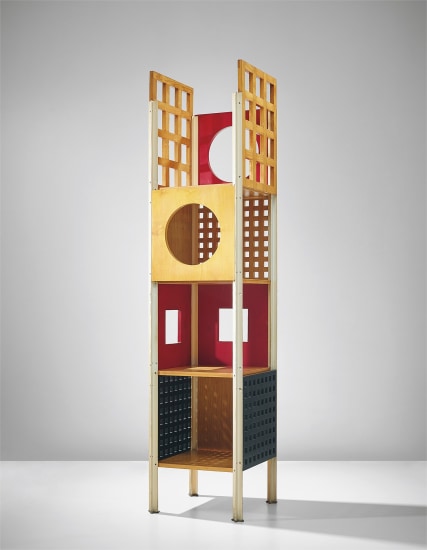


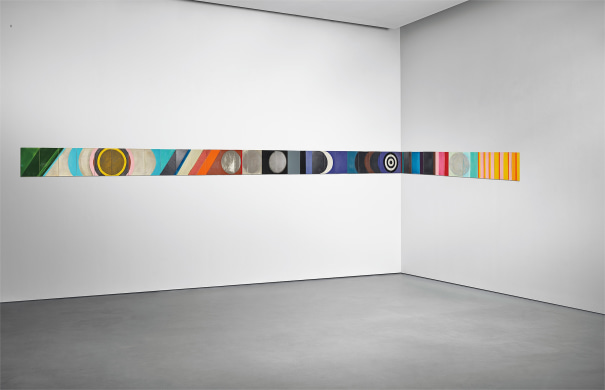



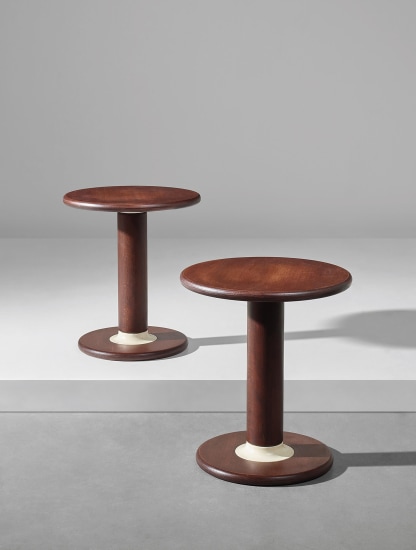
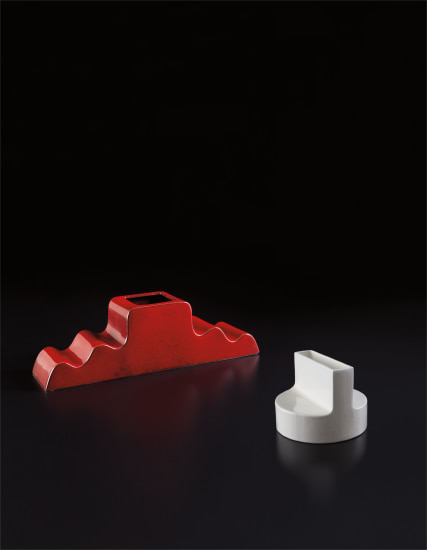
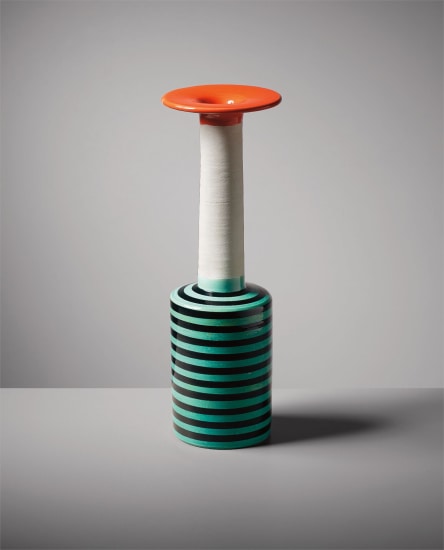
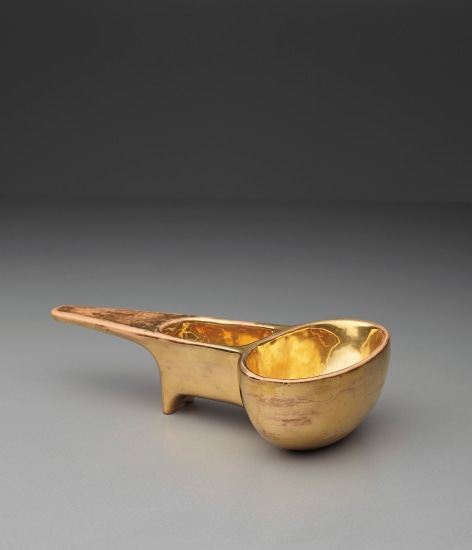
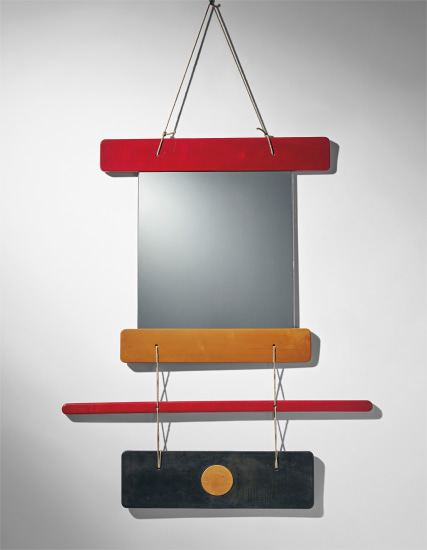

Try LotSearch and its premium features for 7 days - without any costs!
Be notified automatically about new items in upcoming auctions.
Create an alert